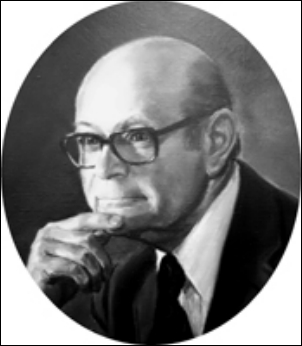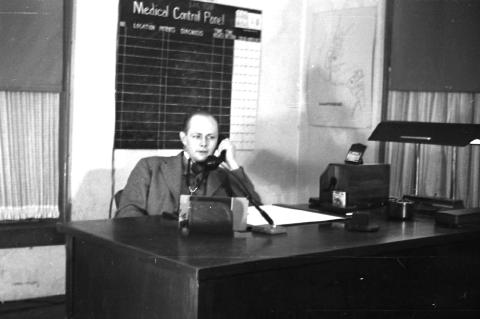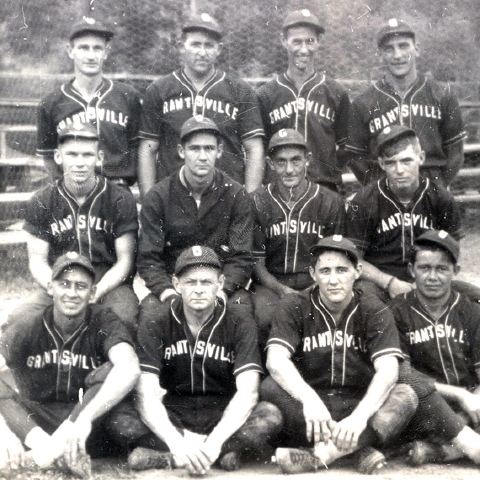
Dr. Curtis P. Artz
By Bob Weaver
A former Calhoun physician, Dr. Curtis P. Artz (1915-1977), went on to become an internationally-known trauma and burn specialist, considered one of the USA's experts and textbook authors on treating burns.
Dr. Artz spent his early life in general practice in the remote hills of Calhoun County during the 1940s and World War II, and was known for his generous spirit and avid softball playing.
"Oldtimers" softball was a hobby a number of Calhoun men, engaged into their 40s.
What wasn't known during his Calhoun years was Dr. Artzs' drive to find better ways to treat patients.
It is fascinating that Dr. Artz went on to become one of nation's leading experts on burns and trauma, but his dedication to the field likely came from experiencing such incidents in Calhoun where medical resources were scarce.
A 1943 newspaper account in the Calhoun Chronicle reports such a case. Minnie Maxine Stallman, three-year-old daughter of Mr. and Mrs. Thurman Stallman of Henrietta, suffered burns when "coal oil" was accidentally sprayed on her clothing by her sister.
The incident "inflicted serious burns and she was rushed to Dr. Dr. C. P. Artz in Grantsville, where medical treatment was rendered," with the child dying.

Dr. Artz was on the World War II Calhoun County Civilian Defense Council and was on the public health board (David Hathaway Collection)
The doctors interest in the advancement of medical treatment could also rest in a 1941 newspaper account, the headline saying "Dr. Artz Uses Latest Developments."
The account says Curt Bower, 64, was injured while hauling sand from the river at Cabot Station, causing serious trauma to his leg.
"His son, Paul, an employee of Godfrey L. Cabot, Inc. and well trained in first aid work, courageously clamped the femoral artery with his fingers and stopped the blood flow, while his father was transferred to Dr. Artz's office."
"He was pale, pulseless and in profound shock when Dr. Artz examined him. After the use of sedatives to allay the pain, Dr. Artz administered Lyovac normal human blood plasma. Lyovac is dried blood plasma in a powdered form which, when compounded with distilled water, produces the same result as the old type blood transfusion."
Dr. Artz accompanied the victim in an ambulance to Parkersburg, administering the plasma, after which he stabilized and recovered from shock, Artz amputating his leg successfully.
The account continued, "It is understood that Dr. Artz is one of the few physicians in the country to have used this new medical development and he should be highly commended for his farsightedness in stocking this blood plasma as an insurance for the people of this community against such accidents."

Grantsville Softball Team
First row, left to right: Gifford Weaver, Dr. Curtis
Artz, Bill Hefner, Bill Harris; Second row: Herb Shimer,
Ron Shimer, Cliff Kersey, Nile Nicholas; Third row:
Lloyd Vaughan, Harlan Hogue, Olen Maloney, Ed Westfall
(Photo Courtesy of Bob Weaver)
Dr. Artz received his B.A. and M.D. from Ohio State University and did his graduate work in surgery at Baylor College.
Artz served in the Army and was assigned to the Surgical Research Unit of the Brooke Army Medical Center, Fort Sam Houston, Texas. While there he founded the Army Burn Center and served as director of the Army Surgical Research team in Korea.
After he left the Army in 1956, Dr. Artz was a faculty member at the University of Mississippi School of Medicine at Jackson and became the first Shrine Professor of Surgery at the University of Texas, Galveston.
He was chairman of the Committee on Trauma of the National Research Council, president of the American Association for the Surgery of Trauma, president of the American Burn Society, and president of the Southeastern Surgical Congress. He made notable contributions to American surgery in a wide field including surgical metabolism, burns, shock, and trauma.
Dr. Artz joined the faculty at the Medical University of South Carolina in 1965. He served as professor and chairman of the Department of Surgery until his untimely death in 1977.
Calhoun native Dr. Charles Albert Stump, who left Calhoun to become a leading Florida obstetrician, says he was inspired by Dr. Artz to go into medicine while attending Calhoun High School, also playing softball with the doctor on the oldtimers softball team.
"Curt believed in finding better ways to help patients, in many ways driven to do so," said Dr. Stump.
Perhaps I owe my life to him, obtaining Penicillin in the early 1940S which was not readily available, treating a life-threatening medical condition when I was four.
He drove several hundred miles to get the antibiotic, a favor to my softball playing dad.
I recovered from a life threatening condition, hospitalized for eight weeks with peritonitis.
| 


